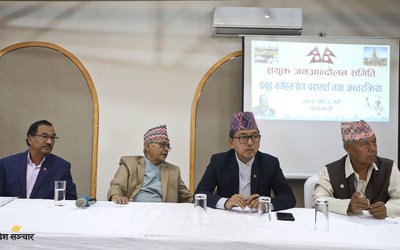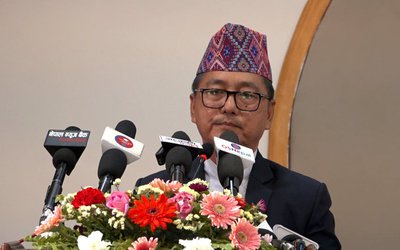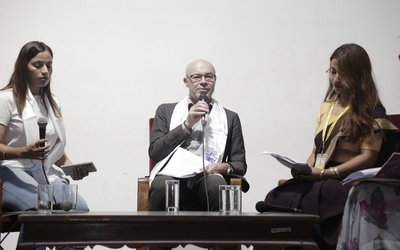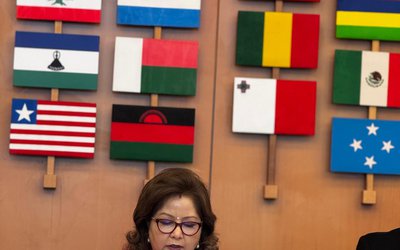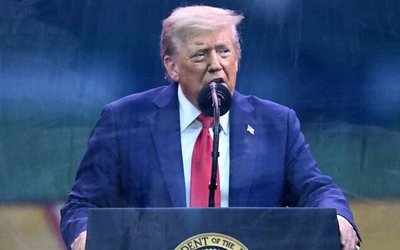
The constitutional
and political limbo following the elections has exposed the inadequacies of the
country’s two-year-old constitution. The formation of a new government is nowhere in sight. That means that
the ruling Nepali Congress, even after a major
setback in the polls early last
December, will continue to rule for some more time. The architect of the constitution — mainly the three major
parties, the Nepali Congress,
Communist Party of Nepal-Unified Marxist Leninist (UML) and the Maoists — appear defenceless when it
comes to dealing with the
ambiguities of the constitution. But they have not gathered courage to admit that truth.
The tussle between the Nepali Congress and the two parties
constituting the Left Alliance is centered
around the latter demanding the
early resignation of the government in deference to the poll verdict. The Nepali Congress, however, insists that it
will wait for the formation of the
Upper House of Parliament, and the notification of all the results including that of members elected
under the proportional
representation system. That will take at least another month.
The UML, which aspires to head the new government because the
Left Alliance has a near
two-thirds majority in Parliament, has reasons to worry about this delay. “We suspect local and external
forces are out to subvert the
peoples’ mandate,” prime ministerial candidate K.P. Oli said. He, however, chose not to delve into the ambiguities
within the constitution that are
behind the current mess. Balkrishna Neupane, a noted constitutional expert , said, “This constitution
is dead for all practical purposes,
but some forces need to say it is dead. Perhaps, the best option will be to have the 1991 constitution
(of the Kingdom of Nepal)
restored.” The current constitution had fixed January 21 as the deadline for holding elections to the federal
parliament. This also meant that
the institution had come into existence immediately after the election results, leading to the formation
of the government.The blame for
this not happening should fall on all the three key political parties.
But the government and the key parties seem to have taken at
least some cognisance of the
public anger and are trying appease the forces they had totally excluded from the constitution-making
process. President Bidhya Devi
Bhandari and Prime Minister Sher Bahadur Deuba, among others, made a beeline to offer homage to the
late king, Prithvi Narayan Shah —
the unifier of modern Nepal — as the government observed his birthday, January 11, as National Unity
Day after a gap of 11 years.
Shah’s ninth-generation descendant and dethroned king,
Gyanendra, received a rousing welcome in western Nepal during
his three-week long tour of the
area, with crowds asking him to take his throne back. “These 601 (number of members in the outgoing parliament)
have plundered the country,” people who called
on the king said.
For a change, senior officials of the police, civil
administration and paramilitary
forces also called on the former king. Gyanendra also crossed over to Lucknow, where he was given a warm
welcome by Chief Minister Yogi
Adityanath on January 8. Both Adityanath and the former king regard Lord Gorakhnath as their presiding deity.
But the meeting between the two is
also seen as India’s opening a line of communication with the former king, 11 years after it played a role in
pushing Nepal towards republicanism by joining
hands with the Maoists and other
political parties.
“The absence of the monarchy is being felt in the country,”
said Ram Sharan Mahat, a prominent
member of the Nepali Congress working committee and a former foreign minister. There are many others who now
believe that outside forces with geo-strategic
interests made a few top political
leaders “pawns” and dismantled the institution of monarchy and discredited the judiciary — so that they
could get de facto power. This
feeling is being articulated more and more, including within the Nepali Congress. Such views could
also give rise to a more strident
“nationalism” , retaliation and intolerance in the long run, if they are not given space in Nepal’s
politics and constitution.
The welcome that the dethroned king got in western Nepal, the
violent protests in several places
against the government’s decision to name temporary centres (capitals) for seven provinces, the Rs 101 billion
borrowed by the government to pay salaries to
its employees and an almost
similar amount needed to relocate its employees to provinces, as Nepal goes federal, are signs that the country’s
constitutional, financial and
political problems will become knottier. The three major parties should be held responsible for this.
But what next?
Nepal can either continue to be governed by a failed constitution, with the rulers using it the way they want. Or the leaders of three parties can give up on their egos and chart out a conciliatory roadmap. For this to happen, they need to admit that they bungled all the opportunities in the past 11 years. But unlike on the previous occasions, they have to find a way out in Nepali territory, involving all internal forces genuinely and seriously.
Courtesy: Indian Express

Yubaraj Ghimire
Ghimire is a Kathmandu based journalist.
- Manmohan Singh And The Churn In Nepal
- Jan 08, 2025
- Why ‘Revolutionary’ Communist PM Prachanda Went To Temples In India
- Jun 08, 2023
- Why China Is Happy With Nepal’s New PM
- Jan 03, 2023
- Prachanda Sworn In As PM: New Tie-ups In Nepal, Concern In India
- Dec 27, 2022
- Young TV Anchor As Its Face, RSP Rise Takes Nepal By Surprise
- Nov 23, 2022




